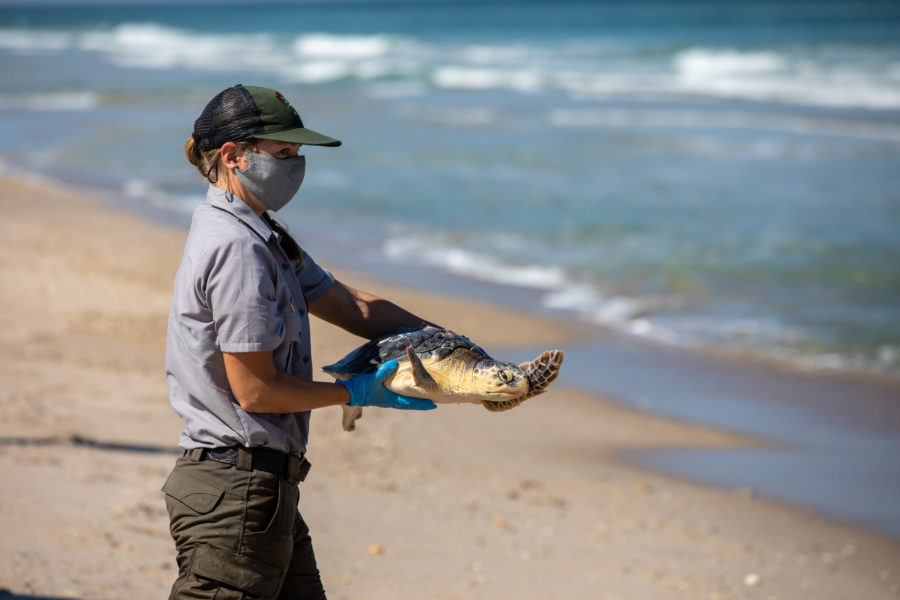Here at the Union of Concerned Scientists, we have bad news and good news.
First, the bad: The federal scientific workforce—in other words, the scientists and experts who work for the government on behalf of the public—needs help. That workforce is aging quickly. It’s not as diverse as it should be. And federal agencies have lost a lot of experts, especially since 2017.
But there’s also good news. In the chasm left by the last administration, federal agencies in the Biden administration can recruit, train, and inspire the next generation of government scientists and civil servants. Could you be part of that next generation?
We think so. Whether you’ve earned a bachelor’s degree or a PhD, federal science needs you—and we at the Union of Concerned Scientists can help you get there.
The problem in numbers
In the last 150 years, US federal science has fueled many of the world’s great achievements. Federally-funded scientists have mapped the human genome, created the World Wide Web, protected species from extinction, and saved lives through revolutionary vaccine campaigns—against polio and smallpox in years past, and today, against COVID-19.
We owe these triumphs, in part, to government scientists. Whether chemist or physician, economist or engineer, each has dedicated their career to the public interest.
But after decades of underinvestment in the federal workforce, cracks have formed in the foundations of government science. Especially since 2017, political officials have stunted or stalled research, emptied scientific offices, and undermined career staff. Some offices, battered by political attacks, have hemorrhaged experts.
My colleagues and I have studied these losses. Last fall, we analyzed years of staffing data from federal agencies. We found that, in the last four years, five federal agencies alone lost more than 1,000 scientists collectively. This confirmed results from our 2018 survey of federal scientists, majorities of whom reported seeing workforce reductions.
This erosion matters. Anemic agencies, bled of their brainpower, cannot do their work. For example, in 2019, the Trump administration abruptly moved the research arm of the Agriculture Department from Washington, DC to Missouri. Three in four staff were forced to resign or retire, taking with them years of institutional knowledge. Economic reports slowed to a trickle. Years-long studies crumbled. And millions of dollars in funding for research—on climate change, food security, antibiotic resistance—sat unreleased.
When our government loses its experts, the public loses, too.
Declining diversity
Our government must also contend with a deeper issue: a mostly white, older, and male scientific workforce.
Consider the gender gap. A House of Representatives investigation found that, at the Department of Energy, there were three men for every woman in the scientific workforce. The National Atmospheric and Oceanic Administration employed 8.5 male engineers for every female engineer. The EPA’s engineering employment gap was responsible for more than half of the gender gap in its entire scientific workforce.
The racial demographics are no better. Among seven major science agencies, most employ two to three times as many white scientists as scientists of color. At the EPA, Black scientific staff declined by nearly 9% (85 people) under Trump and more than 22% in the last decade. Agencies’ scientific workforces are less diverse than their broader workforces.
The federal workforce is aging, too. The average employee in the federal workforce is 5 years older than the average employee nationally. Nearly 30% of federal employees are over 55—and 7% are younger than 30, a vanishingly low number compared to the private sector’s healthy 23%. Retirements are creeping up.
A workforce that lacks diversity—in age, gender, race, ethnicity, background—is as much a pragmatic failing as a moral one. Certainly, our government should look like the public it serves; this is an American ideal. But a diverse government also just works better. Research shows that diversity in scientific groups strengthens innovation, and more diverse teams—able to draw ideas from a broader cross-section of society—achieve better outcomes than homogenous teams.
In short, the status quo is too old, too white, and too few. The American public deserves better.
What can our government do?
In the wake of these losses, the government has an opportunity to not only rebuild its workforce, but reimagine it. The administration has taken promising steps. In June, President Biden signed an expansive executive order directing agencies to promote diversity, equity, inclusion, and accessibility in their workforces. Agencies have announced thousands of job openings, from attorneys to scientists, educators to diplomats.
But hiring is one thing; keeping employees is another entirely. To create a culture that supports employees, the White House has already worked to strengthen protections for federal science—new ethics requirements, stronger scientific integrity policies, and careful investigations into past assaults on science and how to prevent them in the future.
But more must be done. Agencies must make career opportunities accessible to experts from diverse backgrounds—particularly those that have historically been underrepresented in federal science. Agencies must revamp recruiting strategies by establishing relationships with universities, community-based organizations, and the private sector. And agencies must expand their relationships with Historically Black Colleges and Universities, Latino-serving institutions, Tribal colleges and universities, and other institutions that graduate or support underrepresented candidates.
What can you do?
If you’re an early-career scientist, you can do plenty. The government needs bright minds to renew federal science, so if you’re a recent graduate, about to graduate, or seeking a career pivot, consider the civil service.
And federal science isn’t only for those with PhDs. Are you a college grad, eager to safeguard the environment? Become an environmental protection specialist at the EPA. Do you like numbers? Crunch them as a budget analyst for the Education Department. Are you a fan of wilderness preservation? Become a ranger for the National Park Service. Are you a space geek? NASA is hiring.
Of course, applying for federal jobs can be tricky at best and baffling at worst. Many of my colleagues have worked in federal science, and they’re the quick to bemoan the slow and confusing hiring process.
Federal hiring needs to be overhauled—but in the meantime, we’re here to help you through it. The Union of Concerned Scientists created a toolkit to guide scientists through the thorny process of applying for federal jobs, with tips on finding openings, tailoring your resume, and interviewing like a pro. We also compiled resources to help you get started, and we’re working to distribute them to schools and groups across the nation.
What are the perks of federal employment?
If you stick with it, the payoffs of a career in federal science can be enormous. You can work anywhere; in fact, nearly 85% of federal jobs are outside Washington, DC. Most have excellent benefits, including competitive pay, health insurance, and retirement plans. Some positions even pay off student loan debt. And the federal workforce’s looming retirement wave may present young scientists with opportunities for rapid career growth.
The government needs scientists to make our communities and the world healthier, safer, and more prosperous. For the public to benefit from science-based policies, our government needs the very best scientists—including you.

